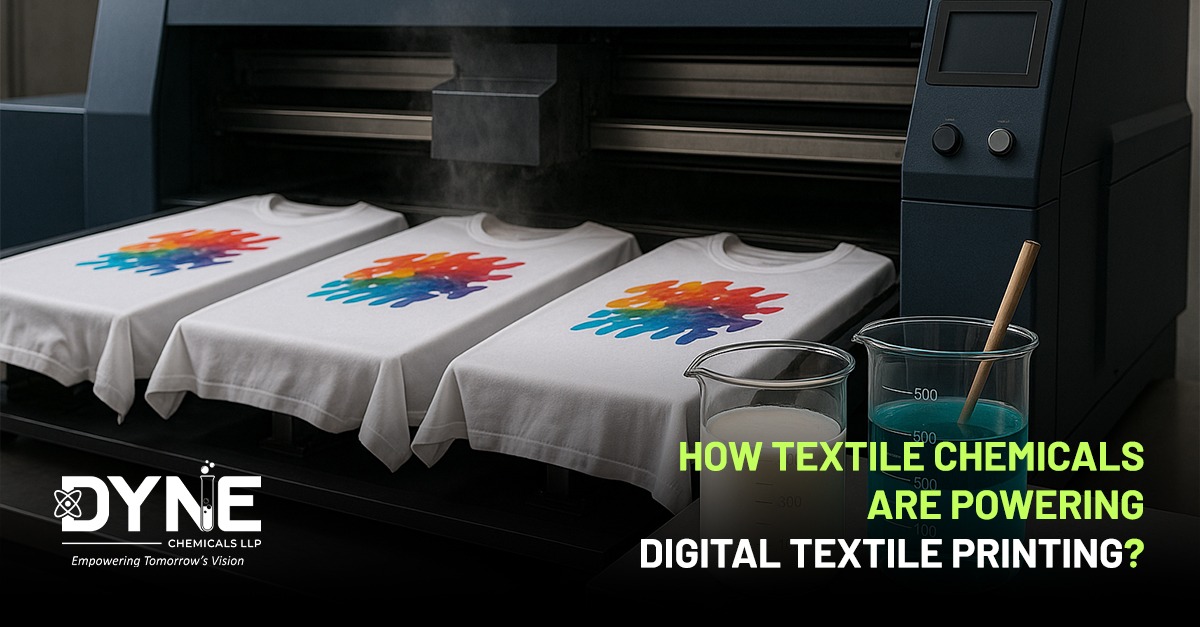Digital textile printing has rapidly emerged as a game-changer in fabric customization and short-run manufacturing. With its ability to deliver high-resolution, low-inventory, and on-demand production, it’s no surprise that digital printing is growing at a CAGR of over 14% globally, with India, Bangladesh, and Vietnam among the fastest adopters.
But while much attention is given to printheads, inks, and RIP software, a powerful enabler often flies under the radar: textile chemicals. From pre-treatment to post-processing, the rise of digital printing has depended heavily on innovations in fabric processing chemicals.
In this blog, we will discuss how textile chemicals are playing a lynchpin role in ensuring precision, performance and sustainability in digital printing.
Substrate Preparation for Optimum Print Quality
A digital printer is only as good as the fabric it prints on, and that fabric must be properly prepared. Textile auxiliaries used in pre-treatment determine how ink interacts with the substrate. The goals are clear. Control ink penetration, boost colour brilliance, improve sharpness, and enhance wash durability.
Whether you are working with reactive inks on cotton or disperse inks on polyester, the choice of pre-treatment chemicals such as wetting agents, thickeners, and pH regulators is vital.
Compatibility with Inks and Fixation
One of the less discussed but substantial challenges in digital textile printing is ink chemistry compatibility. The interaction between the applied organic textile chemicals and the ink determines whether colour bonds successfully with the fibre.
This is where textile chemical innovations such as crosslinkable binders, nano-dispersions, and thermal stabilizers come into play. These agents help:
- Achieve better fixation
- Reduce ink bleeding
- Improve resistance to crocking, washing, and light
In pigment digital printing, for example, high-performance fixatives and binders are indispensable for creating wash-fast prints without post-washing.
Enabling Zero Liquid Discharge
Digital printing has earned its place as an eco-friendlier option, using up to 90% less water than conventional screen printing. But the need for sustainable textile chemicals remains, especially in achieving wash-free or low-wash processes.
In India, where effluent regulation is tightening under Zero Liquid Discharge (ZLD) norms, particularly in Gujarat and Tamil Nadu, manufacturers are shifting to APEO/NPEO-free, biodegradable, and low-foam auxiliaries designed specifically for digital workflows.
This push for sustainability is mirrored in Bangladesh and Turkey, where pressure from global brands is increasing the demand for certified chemicals for sustainable fashion.
Expanding Substrate Possibilities
With market demand diversifying across activewear, home décor, and fashion accessories, digital printers are being pushed to print on new kinds of textiles. Chemistry is responding accordingly.
Dyne’s fabric processing chemicals support digital printing on blends, coated fabrics, and even recycled synthetics by providing surface modification, adhesion promotion, and custom softeners that maintain the fabric’s hand feel.
This expands creative and commercial possibilities without compromising print performance.
Enhancing the Final Touch
Print isn’t the end of the story. Finishing chemicals still play a vital role in ensuring that printed fabrics meet consumer expectations for touch, durability, and function.
Post-print textile auxiliaries such as softeners, anti-crease agents, and hydrophobic finishes help manufacturers deliver added value. This is ever more important in export markets where product performance is tightly evaluated.
Dyne Enabling Local Access to Global-Grade Chemistry
One of the key challenges in fast-growing textile regions like Vietnam, Bangladesh, and Indian textile clusters is access to digital-compatible, high-purity chemistry.
Dyne Chemicals addresses this by offering a full range of textile chemical solutions optimized for digital workflows, whether reactive, pigment, disperse, or sublimation. With technical support and supply capability across South Asia and the Middle East, we enable printers to maintain speed, quality, and consistency across batches.
Chemistry Designed for Precision, Performance, and Compliance
Digital textile printing is often framed as a software-and-hardware revolution. But its real power lies in the seamless coordination of chemistry and technology. Without the right textile chemical innovations, even the most advanced printer can deliver subpar results.
As the textile world leans into customization, speed, and sustainability, textile chemicals are actively shaping its evolution.
Looking to optimize your digital printing setup? Talk to the Dyne team to explore chemistry designed for precision, performance, and compliance.

